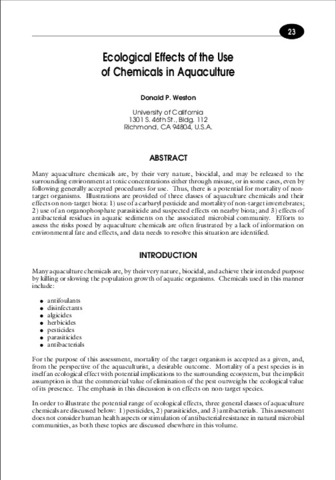Ecological effects of the use of chemicals in aquaculture
- Global styles
- MLA
- Vancouver
- Elsevier - Harvard
- APA
- Help
Share
Abstract
Many aquaculture chemicals are, by their very nature, biocidal, and may be released to the surrounding environment at toxic concentrations either through misuse, or in some cases, even by following generally accepted procedures for use. Thus, there is a potential for mortality of nontarget organisms. Illustrations are provided of three classes of aquaculture chemicals and their effects on non-target biota: 1) use of a carbaryl pesticide and mortality of non-target invertebrates; 2) use of an organophosphate parasiticide and suspected effects on nearby biota; and 3) effects of antibacterial residues in aquatic sediments on the associated microbial community. Efforts to assess the risks posed by aquaculture chemicals are often frustrated by a lack of information on environmental fate and effects, and data needs to resolve this situation are identified.
Suggested Citation
Weston, D.P. (2000). Ecological effects of the use of chemicals in aquaculture. In J. R. Arthur, C. R. Lavilla-Pitogo, & R. P. Subasinghe (Eds.), Use of Chemicals in Aquaculture in Asia: Proceedings of the Meeting on the Use of Chemicals in Aquaculture in Asia, 20-22 May 1996, Tigbauan, Iloilo, Philippines (pp. 23-30). Tigbauan, Iloilo, Philippines: Aquaculture Department, Southeast Asian Fisheries Development Center.
Type
Conference paperISBN
9718511490Collections



